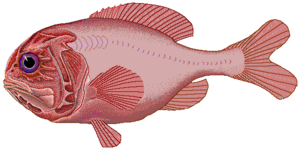Hoplostethus atlanticus
| Hoplostethus atlanticus | ||||||||||||
|---|---|---|---|---|---|---|---|---|---|---|---|---|

Hoplostethus atlanticus |
||||||||||||
| Systematics | ||||||||||||
|
||||||||||||
| Scientific name | ||||||||||||
| Hoplostethus atlanticus | ||||||||||||
| ( Collett , 1889) |
Hoplostethus atlanticus , also known as emperor perch , orange roughy or granate perch, is a relatively large deep sea fish . It occurs in cold (3–9 ° C), deep ( bathypelagic , approx. 180–1800 m) waters of the western Atlantic (north of Nova Scotia ), eastern Atlantic (from Iceland to Morocco , Namibia to South Africa ), between New Zealand and Australia and in the Eastern Pacific off Chile .
The Orange Roughy is known for the fact that it is said to be very old (up to approx. 150 years) and that it does not reach reproductive age until approx. 30–35 years. However, this information is controversial; Little is known about the real life cycle of animals. If they are correct, many of the specimens fished today hatched before the First World War . The stocks are then likely to recover extremely slowly and, if current catches are maintained, be quickly depleted. The role of the grenade perch in the deep sea ecosystem and the consequences of its disappearance for other species has not yet been sufficiently clarified. What is certain is that it lives in flocks of all ages and that it undertakes long hikes. In doing so, they may follow deep-sea currents.
The fish is of great importance for deep-sea fishing and is often offered in the trade as food fish. It is also sold in Germany, but is mainly eaten in the UK, USA, China and Australia. Its brick-red color diminishes to a yellowish orange after death. With a maximum size (including tail fin) of 75 cm and a maximum weight of 7 kg, the grenade is the largest known representative of the Trachichthyiformes to date . However, most commercially caught specimens are only 30-40 cm in size by default, which shows that the fishing fleets do not offer adult specimens for sale.
In 2007, the governments of New Zealand and Australia banned the orange roughy fishery indefinitely because stocks had collapsed. After the two states introduced a surveillance and recovery program, the Orange Roughy fishery received MSC certification in late 2016 and the fish is allowed to be caught again.
Web links
- Hoplostethus atlanticus on Fishbase.org (English)
Individual evidence
- ↑ a b c Robert Kunzig: The hunt on the underwater mountain. In: folio.nzz.ch. Folio Neue Zürcher Zeitung, July 1, 2007, accessed on February 16, 2017 .
- ↑ Anja Franzenburg: Ban on fishing for fish. In: greenpeace.de. Greenpeace, December 3, 2007, accessed February 16, 2017 .
- ↑ MSC certification for the New Zealand shellfish. (No longer available online.) In: msc.org. Marine Stewardship Council, September 12, 2016, archived from the original on February 16, 2017 ; accessed on February 16, 2017 . Info: The archive link was inserted automatically and has not yet been checked. Please check the original and archive link according to the instructions and then remove this notice.

